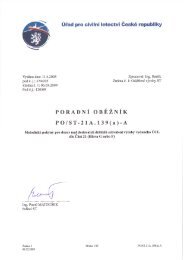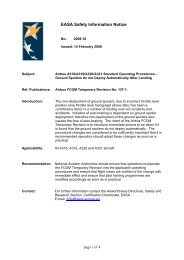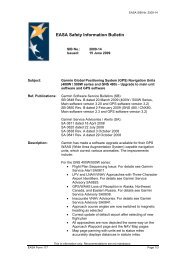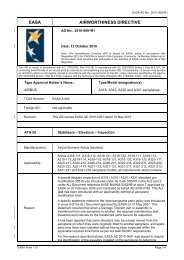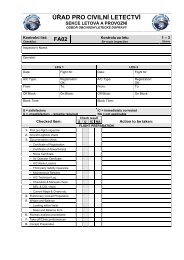1 [Federal Register: April 7, 2005 (Volume 70, Number 66)] [Rules ...
1 [Federal Register: April 7, 2005 (Volume 70, Number 66)] [Rules ...
1 [Federal Register: April 7, 2005 (Volume 70, Number 66)] [Rules ...
You also want an ePaper? Increase the reach of your titles
YUMPU automatically turns print PDFs into web optimized ePapers that Google loves.
FOR FURTHER INFORMATION CONTACT: Gregg Nesemeier, Aerospace Engineer, Systemsand Equipment Branch, ANM-130S, FAA, Seattle Aircraft Certification Office, 1601 Lind Avenue,SW., Renton, Washington 98055-4056; telephone (425) 917-6479; fax (425) 917-6590.SUPPLEMENTARY INFORMATION: The FAA proposed to amend 14 CFR Part 39 with an ADfor certain Boeing Model 737-600, -<strong>70</strong>0, -800, and -900 series airplanes. That action, published in the<strong>Federal</strong> <strong>Register</strong> on January 5, <strong>2005</strong> (<strong>70</strong> FR 733), proposed to require installing and testing anupdated version of the operational program software of the flight control computers.CommentsWe provided the public the opportunity to participate in the development of this AD. We haveconsidered the comments that have been submitted on the proposed AD.Support for the Proposed ADTwo commenters support the AD as proposed. A third commenter supports the intent of theproposed AD.Request To Prohibit Testing in Revenue ServiceOne commenter requests that we prohibit testing of the updated software in revenue service. Thecommenter provides no justification for the request. We infer that the commenter believes theproposed AD would require a flight test of the updated software installation, and that performing aflight test during revenue service would pose undue hazard to airplane occupants.We do not agree because we believe the commenter has misunderstood the testing requirementof this AD. The test of the updated version of the operational program (OPS) software is a ground testperformed by maintenance personnel, not a flight test. This test, which must be satisfactorilyaccomplished before returning an airplane to service, is adequate for ensuring that the OPS softwareis properly installed and updated. Therefore, no change to this final rule is necessary in this regard.ConclusionWe have carefully reviewed the available data, including the comments that have beensubmitted, and determined that air safety and the public interest require adopting the AD as proposed.Costs of ComplianceThere are about 155 airplanes of the affected design in the worldwide fleet. This AD affectsabout 34 airplanes of U.S. registry. The actions take about 2 work hours per airplane, at an averagelabor rate of $65 per work hour. Required parts cost about $0 per airplane. Based on these figures, theestimated cost of this AD for U.S. operators is $4,420, or $130 per airplane.Authority for This RulemakingTitle 49 of the United States Code specifies the FAA's authority to issue rules on aviation safety.Subtitle I, Section 106, describes the authority of the FAA Administrator. Subtitle VII, AviationPrograms, describes in more detail the scope of the Agency's authority.We are issuing this rulemaking under the authority described in Subtitle VII, Part A, Subpart III,Section 44<strong>70</strong>1, ''General requirements.'' Under that section, Congress charges the FAA withpromoting safe flight of civil aircraft in air commerce by prescribing regulations for practices,2
methods, and procedures the Administrator finds necessary for safety in air commerce. Thisregulation is within the scope of that authority because it addresses an unsafe condition that is likelyto exist or develop on products identified in this rulemaking action.Regulatory FindingsWe have determined that this AD will not have federalism implications under Executive Order13132. This AD will not have a substantial direct effect on the States, on the relationship between thenational government and the States, or on the distribution of power and responsibilities among thevarious levels of government.For the reasons discussed above, I certify that this AD:(1) Is not a ''significant regulatory action'' under Executive Order 128<strong>66</strong>;(2) Is not a ''significant rule'' under DOT Regulatory Policies and Procedures (44 FR 11034,February 26, 1979); and(3) Will not have a significant economic impact, positive or negative, on a substantial number ofsmall entities under the criteria of the Regulatory Flexibility Act.We prepared a regulatory evaluation of the estimated costs to comply with this AD. See theADDRESSES section for a location to examine the regulatory evaluation.List of Subjects in 14 CFR Part 39Air transportation, Aircraft, Aviation safety, Incorporation by reference, Safety.Adoption of the AmendmentAccordingly, under the authority delegated to me by the Administrator, the FAA amends 14 CFR part39 as follows:PART 39–AIRWORTHINESS DIRECTIVES1. The authority citation for part 39 continues to read as follows:Authority: 49 U.S.C. 106(g), 40113, 44<strong>70</strong>1.§ 39.13 [Amended]2. The FAA amends § 39.13 by adding the following new airworthiness directive (AD):3
AIRWORTHINESS DIRECTIVEAircraft Certification ServiceWashington, DCWe post ADs on the internet at "www.faa.gov"U.S. Departmentof Transportation<strong>Federal</strong> AviationAdministrationThe following Airworthiness Directive issued by the <strong>Federal</strong> Aviation Administration in accordance with the provisions of Title 14 of the Code of <strong>Federal</strong> Regulations (14 CFR) part 39,applies to an aircraft model of which our records indicate you may be the registered owner. Airworthiness Directives affect aviation safety and are regulations which require immediateattention. You are cautioned that no person may operate an aircraft to which an Airworthiness Directive applies, except in accordance with the requirements of the AirworthinessDirective (reference 14 CFR part 39, subpart 39.3).<strong>2005</strong>-07-20 Boeing: Amendment 39-14045. Docket No. FAA-2004-19986; Directorate Identifier2004-NM-247-AD.Effective Date(a) This AD becomes effective May 12, <strong>2005</strong>.Affected ADs(b) None.Applicability(c) This AD applies to Boeing Model 737-600, -<strong>70</strong>0, -800, and -900 series airplanes, certificatedin any category, as identified in Boeing Alert Service Bulletin 737-22A1164, dated May 20, 2004.Unsafe Condition(d) This AD was prompted by a report of an airplane pitching up with rapidly decreasingindicated airspeed after the flightcrew set a new altitude into the autopilot. We are issuing this AD toprevent anomalous autopilot operation that produces a hazardous combination of airplane attitude andairspeed, which could result in loss of control of the airplane.Compliance(e) You are responsible for having the actions required by this AD performed within thecompliance times specified, unless the actions have already been done.Install and Test Updated Software(f) Within 12 months after the effective date of this AD, install and test an updated version of theoperational program software of the enhanced digital flight control system (EDFCS) flight controlcomputers (FCCs), in accordance with Boeing Alert Service Bulletin 737-22A1164, dated May 20,2004.Alternative Methods of Compliance (AMOCs)(g) The Manager, Seattle Aircraft Certification Office, FAA, has the authority to approveAMOCs for this AD, if requested in accordance with the procedures found in 14 CFR 39.19.4
Material Incorporated by Reference(h) You must use Boeing Alert Service Bulletin 737-22A1164, dated May 20, 2004, to performthe actions that are required by this AD, unless the AD specifies otherwise. The Director of the<strong>Federal</strong> <strong>Register</strong> approves the incorporation by reference of this document in accordance with 5U.S.C. 552(a) and 1 CFR part 51. To get copies of the service information, contact BoeingCommercial Airplanes, P.O. Box 3<strong>70</strong>7, Seattle, Washington 98124-2207. To view the AD docket, goto the Docket Management Facility, U.S. Department of Transportation, 400 Seventh Street SW.,room PL-401, Nassif Building, Washington, DC. To review copies of the service information, go tothe National Archives and Records Administration (NARA). For information on the availability ofthis material at the NARA, call (202) 741-6030, or go tohttp://www.archives.gov/federal_register/code_of_federal_regulations/ibr_locations.html.Issued in Renton, Washington, on March 30, <strong>2005</strong>.Kalene C. Yanamura,Acting Manager, Transport Airplane Directorate, Aircraft Certification Service.[FR Doc. 05-6762 Filed 4-6-05; 8:45 am]BILLING CODE 4910-13-P5


![1 [Federal Register: April 7, 2005 (Volume 70, Number 66)] [Rules ...](https://img.yumpu.com/49722490/1/500x640/1-federal-register-april-7-2005-volume-70-number-66-rules-.jpg)
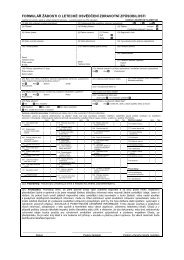
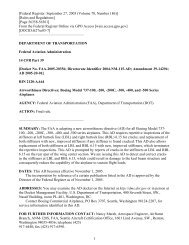
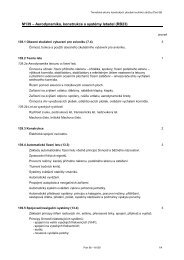
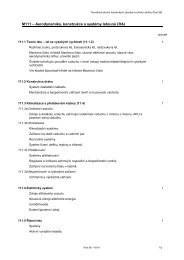
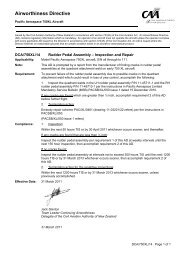
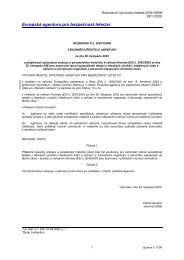
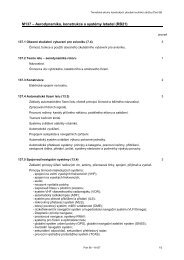
![AD 2010-0014 [PAD 09-006] Eurocopter ...](https://img.yumpu.com/50958012/1/184x260/ad-2010-0014-pad-09-006-eurocopter-.jpg?quality=85)
